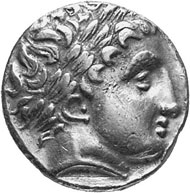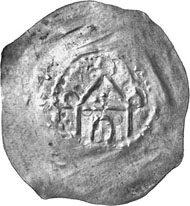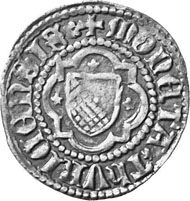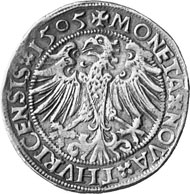Introduction ‘The People of Zurich and their Money’ Part 1
courtesy of MoneyMuseum
Our series ‘The People of Zurich and their Money’ will present one exciting chapter of Swiss numismatics and economic history at a time. The introduction provides an initial overview in two parts. Follow along in this first section as we trace the evolution of Swiss numismatics from the beginning all the way through to the 16th century.
Celts. Helvetii? Stater of Soy-Type, after 250. Head of Apollo with laurel wreath facing right. Rev. Biga galloping towards the right.
Celtic Beginnings
It was during the Celtic period that the ancestors of the modern-day people of Zurich first came into contact with the Greek ‘invention’ of money. The exact point in time that Celtic tribes first started minting their own coins, however, is currently under debate, with possible dates ranging from the middle of the 3rd century to the middle of the 2nd century. What we can say with certainty is that at the beginning of the 1st century BC, the monetary economy complemented the barter economy in the region we know today as Zurich, an assertion substantiated by numerous discoveries of Potin coins.
This small change made of base metal wasn’t used to accumulate hoards or settle high payments, but was instead used for paying small everyday amounts. Given this evidence, it’s likely that the monetary economy was already fairly widespread in Zurich by that time.
During the Roman Empire
With the conquest of the Alpine foothills by Drusus and Tiberius in the year 15 BC, the Roman monetary system also spread throughout the area of modern-day Zurich. In the civic settlements in particular, a sophisticated monetary economy supplanted the barter system. During the 1st and 2nd centuries AD, the denarius dominated economic transactions across the entire Roman Empire. It remained stable for close to 200 years, and 25 denarii could be exchanged for one aureus, a gold coin. The monetary system only began to come apart once the defense of Roman borders started costing the central government more than could be gathered through taxes and duties alone. As a result, the money became ‘inferior,’ such that the silver content of the denarius and its successor, the antoninianus, was reduced to the bare minimum. Since coins at this time carried not only a face value, as they do today, but also an actual metal value that had a bearing on their users’ trust levels, inflation occurred. Roman money became increasingly less important, especially in rural areas.
Zürich. Stamping of Fraumünster Abbey. Dünnpfennig, 2nd half of the 11th century. Church facade. Rev. Cross, ringlet between crossbeams.
The Minting Right of Fraumünster Abbey
The regular supply of Roman coins to Switzerland ended in the year 401, when Stilicho called the Roman soldiers out of the province and back to Italy. With this, the local population was left to its own devices. The supply of Roman coins stopped and the monetary economy was replaced by a barter economy. Gold coins complemented this system, and were used for dealings that went beyond the everyday and involved high sums. This system was maintained during the time of the Migration Period and throughout the entire Early Middle Ages. The odd coins of the Merovingians, the Carolingian kings or of the dukes of Swabia, issued over the course of the next 600 years, barely played any role in daily life.
The same seems to have been true for stampings that are today assumed to have been issued by commission bid of the abbess of Fraumünster Abbey. It’s likely that Henry III, King of Germany from 1039 to 1056, had given her minting privileges as early as the year 1045, although this is only first documented in writing in 1238.
The minting right also carried with it considerable material advantages – the so-called seigniorage fell upon the minting authority. Minting coins was therefore a business, not a service, and, as such, coins were only issued when a profit could be made or the silver content was reduced until minting was actually lucrative. Obviously this system wasn’t very useful when it came to providing a steady supply of stable-value money to a growing civic community that needed it for trade. And so, it was simply in the citizens’ best interests to intervene in matters of coinage.
Zurich. Penny, Type “quadri-flapped bracteate.” Bust of the abbess of the Fraumünster with veils from the front.
The Rise of the Citizens of Zurich
A city had arisen out of the old Roman settlement beside the Fraumünster. During the 13th century, the merchants who lived there became increasingly important. This was in large part due to the opening up of the Schöllenen Gorge, through which the Gotthard Pass became the most important trade route between Italy and the Rhine. Zurich’s location on this route meant that it continued to gain significance as a transport hub and goods distribution centre.
The wealth and prosperity afforded by trade imbued the citizens with a new sense of self-assurance and confidence towards the abbess, and they began to have a say in the dealings of Fraumünster Abbey. While in 1238, for example, the abbess would still have leased her minting right to private contractors, by 1272 she was consulting with the Zurich city council in order to obtain their approval on the choice of leaseholders for her mints. Civic officials were granted the right to conduct quality control inspections of the mints in order to ensure a consistent penny value. In 1364, the abbess sealed her lease contract directly with the mayor, the council and the guild masters, effectively putting the minting right in the hands of the city of Zurich, even if not doing so in strictly legal terms.
Zurich. Stamping of the city. Plappart, 1425-1440. Zurich coat of arms in a quatrefoil. Rev. Eagle.
Between the Habsburgs and the Confederates
The opening of the Gotthard Pass didn’t just mean an easier trade route to Italy; it also spelled new strategic importance for the three cantons (Uri, Schwyz and Unterwalden). This new status prompted the German emperor, a Habsburg, to try to assert his power more effectively in these regions, the aftermath of which is treasured as part of Swiss legend. At any rate, Zurich aligned itself with the confederates in 1351.
This meant problems for all the Zurich nobility who were obliged to the Habsburgs as vassals. The residents of Zurich forced them to decide whether they wanted to trust in the protection of the Habsburgs or of the civil community of Zurich and, as a result, over time most sovereign aristocracies merged into the territory of Zurich.
While the city of Zurich continued to grow and expand its power, things went steadily downhill for Fraumünster Abbey. It experienced its lowest point under Anastasia of Hohenklingen, abbess from 1412 to 1429. Her constant cash deficit forced her to sell many of the abbey’s important commodities and privileges, likely including the minting right. This is evidenced in the fact that Zurich was minting coins in its own name by 1418 at the latest, without having signed a new lease contract with the abbess. In 1425, Sigismund, King of Germany from 1410 to 1437, approved the city of Zurich’s right to its own coinage, while stipulating that the Fraumünster also had this privilege. The abbess, however, refrained from taking further advantage of this privilege from this point until the dissolution of the abbey in the year 1524.
Big Cities Need a Lot of Money
International trade underwent enormous growth during the first third of the 15th century. New forms of money transfer that had been common in Italy since the 14th century also became widespread in Zurich. These included not just the use of bills of exchange (a tool for nationwide, cashless transactions), but also internationally accepted gold coins like the ones minted by Florence, Genoa and Venice. As Zurich only had the right to mint silver, it had to rely on foreign stampings when it came to gold coins. And so, the Florentine gold coin, called the gulden in Zurich, became the city’s most popular trade coin. It was so important, in fact, that the people of Zurich were still calculating in gulden accounts of 40 shillings in the 19th century, long after actual guldens had stopped circulating.
With the enormous growth in goods and trade links, the climate was right to consider minting heavier coins for larger amounts. First attempts were made with the plappart, which was first minted in 1417. Twenty-six of them equalled one gold gulden.
Zurich. Dicken 1505. The city’s patron saints Felix and Regula, their severed heads in their hands. Rev. Eagle.
This progress was brought to a standstill, however, by the economic decline that followed plague and war, and it was only a half century later, around 1500, that Zurich began to emulate Bern’s sophisticated and precisely structured monetary system. In Bern there were gold guldens, guldiners (silver coins in the value of a gold gulden), dicken and batz. At first, Zurich limited itself to silver coins. It wasn’t until 1521 that it received the royal right to mint gold coins from Charles V, King of Germany from 1519 until 1556. The granting of this right meant that Zurich could mint coins as needed for its marketplace, and coins useful for business transactions.
Zurich. Gold gulden 1526, minted under mint master Niklaus Sitkust. The Zurich coat of arms in trefoil. Rev. Crowned shield with imperial eagle.
The Reformation
In 1523, the Zurich city council decided to allow Huldrych Zwingli a sermon according to the Scriptures, thereby giving Zurich its own church under the auspices of the Council.
The Council, of course, laid claim to the control of church property, which included huge quantities of altar vessels made of precious metal. The Council melted them down and had the metal minted into coins.
Zurich. Thaler undated, minted under mint master Hans Jakob I. Stampfer (Mint master 1558-1563). Two lions hold a coat of arms, an orb and a crown. Rev. Imperial eagle.
The Greatest Zurich Coinage
The confiscated church property meant that Zurich had multiplied its financial resources. In fact, the surpluses from the secularized possessions allowed Zurich to bear the costs from the Second War of Kappel (when the reformed Zurich lost the battle at Kappel am Albis in 1531 against the five Catholic localities of Luzern, Uri, Schwyz, Ob- and Nidwalden and Zug) without having to request additional funds through taxation of its citizens. In 1553, the city fathers started assembling a covert treasury that was stored in Great Minster and from which loans to non-residents of Zurich could also be administered.
With this comes arguably the most important coin mission ever in Zurich. Between 1555 and 1561, two mint masters minted more than 9 million coins on behalf of the city, an astonishing number for that time.
Rolling Mill Replica in the Hall Museum.
Just by way of comparison – more coins were minted here in six years than in the entire first half of the 18th century. To produce this vast quantity of coins, they procured the most modern technology available at the time: a rolling mill, which made its way from Zurich to Hall in Tyrol before becoming widespread worldwide.
The Difficult Everyday Life of Payment Transactions
The production of coins decreased again significantly after 1563. During the 16th century, there was no continuous minting as we know it today. Until well into the 19th century, in fact, furnishing an economy with sufficient hard cash didn’t necessarily require one’s own coinage. It was enough to carefully control which coins were permitted to circulate within a city and which were not; to that end, a city-appointed agent inspected the types of coins circulating in the marketplace and then suggested the rate at which these coins should be bought to city council. The Council made the foreign exchange rates of the most common coins available in the city so that residents could follow them; the more rare coins had to be brought to the mint where the mint master would exchange them – for a hefty fee of course – into the established money of the city. If a particular city’s stamping deteriorated drastically in terms of weight or fineness, it was ‘discredited,’ and its use forbidden in the marketplace.
If you’d like to know more about how coins were minted in the 16th century, we recommend this article.
The second part of the introductory overview will take us from the Thirty Years War all the way to the present day.
You can find all parts of the series ‘The People of Zurich and their Money’ here.
The text originates from the catalogue of an exhibition of the same name at the MoneyMuseum.






















